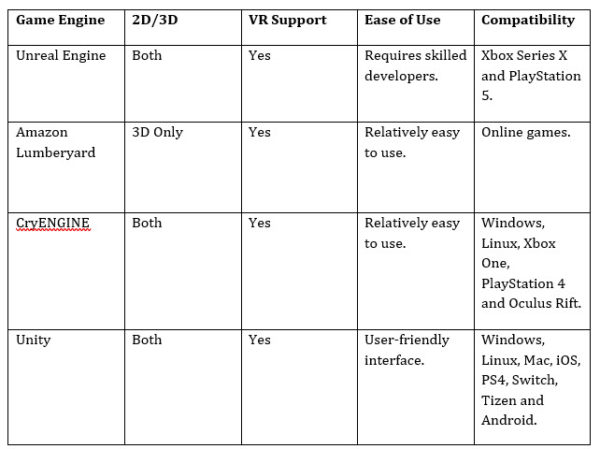The gaming industry has been developing steadily in the past few years. Reports suggest that the market will be worth more than 200 billion USD by 2023. Different facets of the gaming industry have contributed to its growth. For instance, the popularity of online casino games such as online roulette real money has helped the industry register significant growth. Game developers have also contributed to the industry’s growth by combining great imagination, coding skills and choosing suitable game engines.
The developers must make the right choices when selecting the game engine platform. This article looks at top gaming engines and the differences between them. Let’s dig in!
What Makes a Modern Gaming Engine?
An excellent gaming engine should allow you to solve several issues in one place. In this sense, an average game engine should allow you to tackle issues such as:
- Visual Assets Processing: Game engines allow developers to work on lighting, field depth, lighting, shading and texture-mapping with minimal programming effort.
- Physics: An incredible gaming engine should allow you to perfectly balance simulation quality and end users’ computing power limitations. This would help provide excellent in-game immersions.
- Input: This is a prevalent issue in cross-platform development. Select a gaming engine that would allow you to sort out this issue.
Top Gaming Engines
Unreal Engine
This is one of the most popular game engines. Epic Games owns this multi-platform engine that businesses of all sizes can use. It uses real-time technology to transform ideas into immersive visual content.
The engine’s most significant advantage is it allows you to make enough modifications resulting in unique gaming experiences. But, you must be a skilled developer with tremendous experience. Most next-gen consoles such as Xbox Series X and PlayStation 5 are using it.
Strengths
- It has impressive scalability.
- It has a wide range of customization abilities.
- Developers can access numerous features.
- It offers 2D and 3D capabilities.
Amazon Lumberyard
As the name suggests, Lumberyard is Amazon’s all-inclusive offering. It is a 3D game engine developed to create games and fan communities. Its notable features include visual scripting tools, VR preview mode and Twitch integration.
The game engine is powered by Amazon Web Services, meaning it is easier to build games for online play. Lumberyard has excellent native support for P2P, C++ and client topology. It also supports Adobe Photoshop and Autodesk Maya.
Strengths
- It comes with far-reaching capabilities.
- It has a wide range of features.
CryENGINE
This free-to-use platform gives developers access to full engine source code and all its features without paying any license fees. CryENGINE is also an excellent option to buy in-game purchases which are in the game engine’s marketplace. You can also access many free learning resources despite their questionable effectiveness.
Strengths
- It offers extraordinary VR support.
- Developers enjoy stunning visual capabilities.
- They also enjoy a solid interface.
Unity
This multi-platform game engine makes it effortless to develop interactive 3D content. Many large organizations love this gaming engine because it offers excellent functionality, top-quality content and the ability to use it in any game type.
It boasts an all-in-one editor compatible with iOS, Windows, Mac and Linux. It is also compatible with Tizen, Android, Xbox and Switch. Its user-friendly interface makes the development process effortless and reduces the training time.
Strengths
- It offers multi-platform support.
- It is excellent for teams of different sizes.
- It also offers 2D and 3D capabilities.
Comparison Table

- Using Modern Technology to Purchase Life Insurance in Australia: Strategies - July 11, 2025
- Do VPNs Cause Lag - June 25, 2025
- Smart Contracts at the Card Table: Automating Trust in Online Poker Rooms - June 25, 2025



